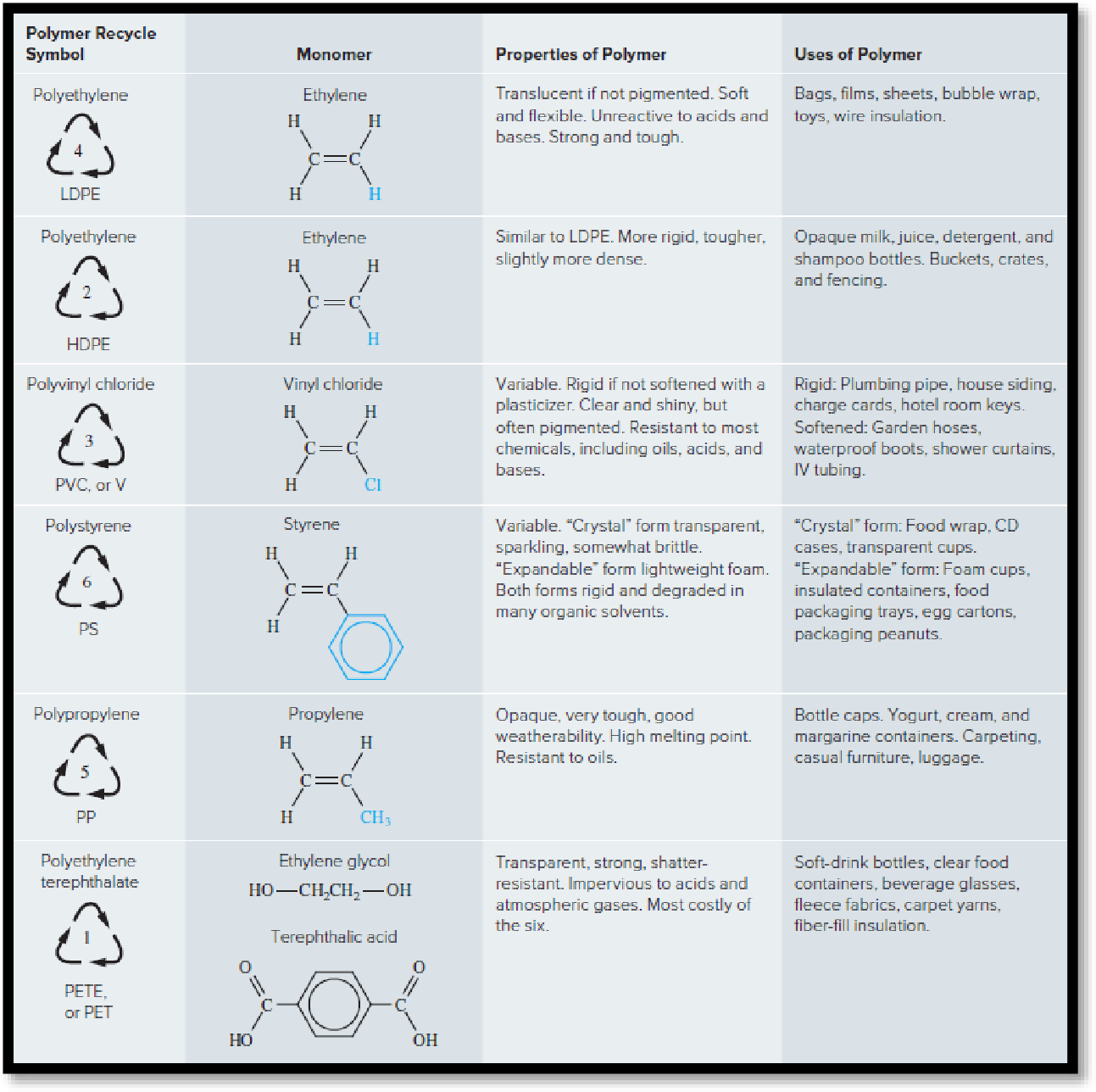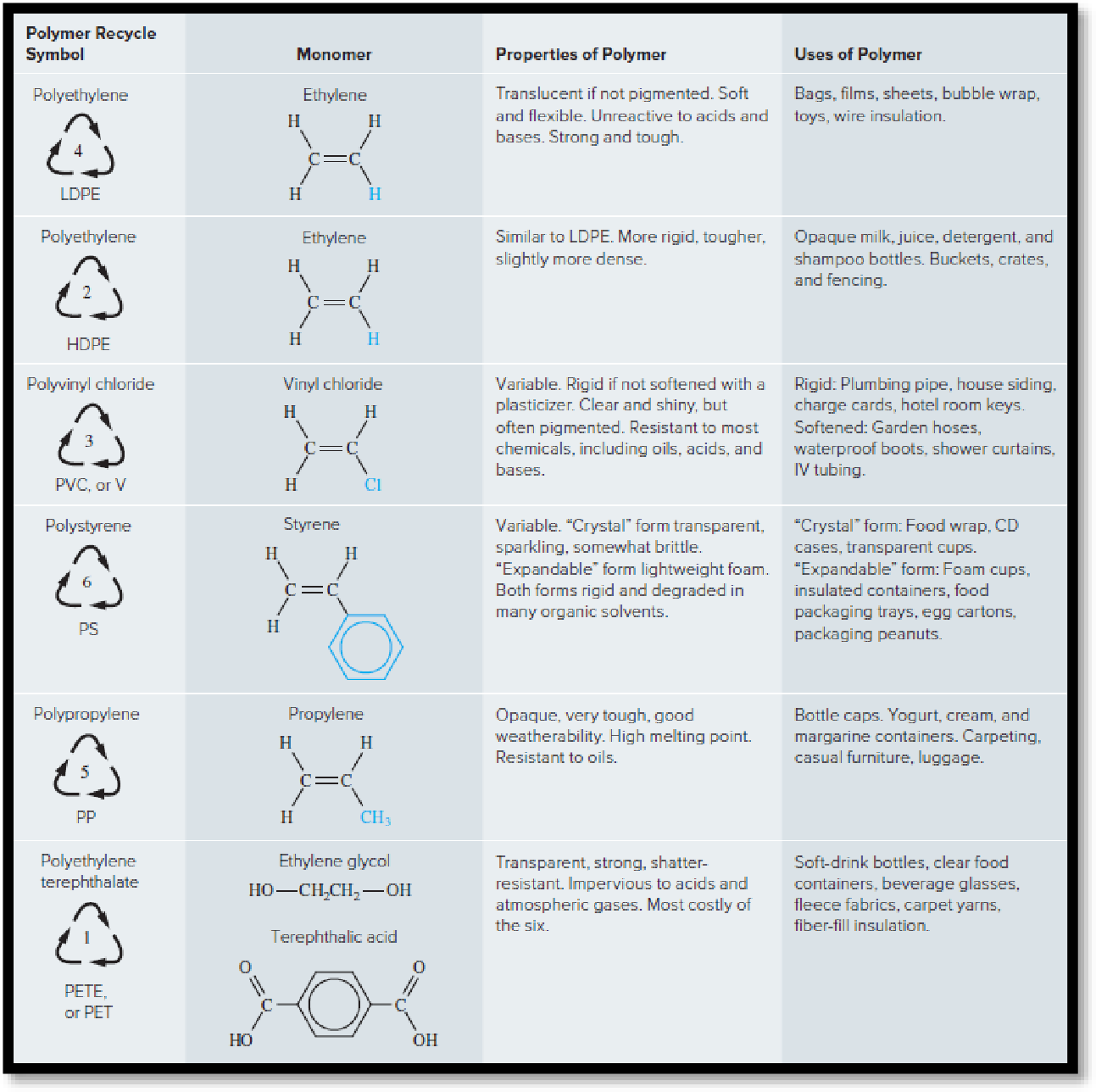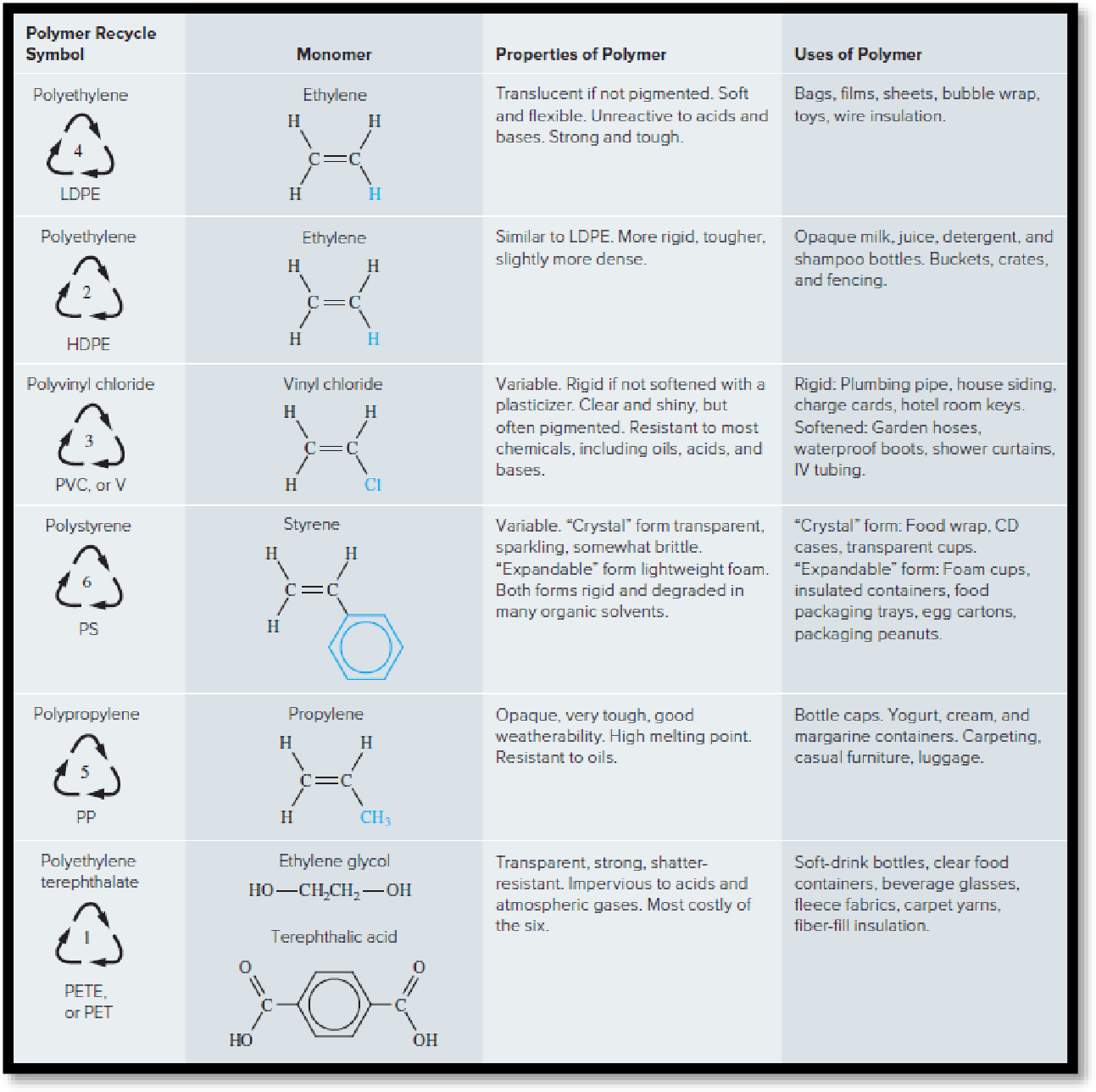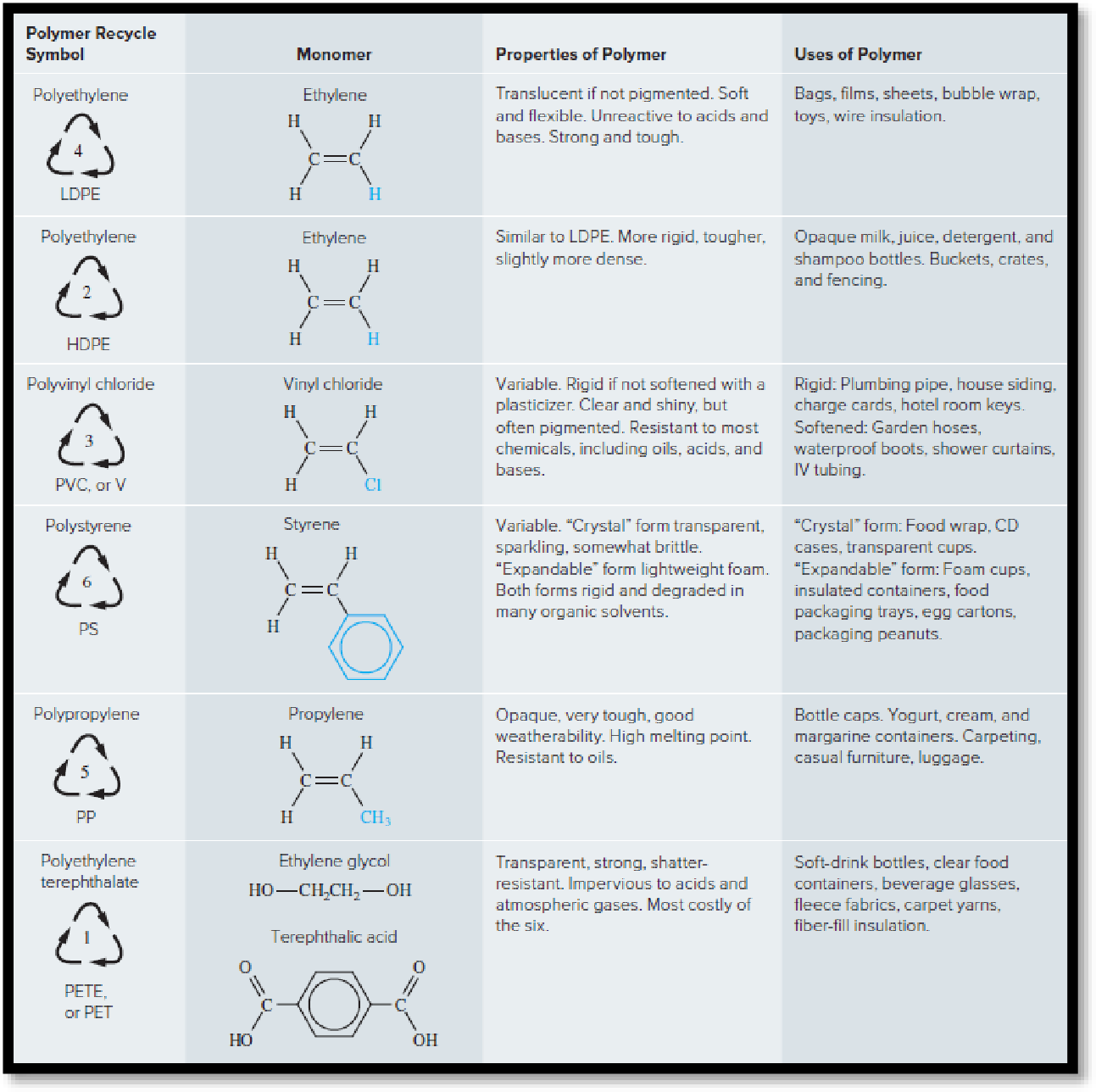
Concept explainers
(a)
Interpretation:
From the big six polymer, polymer used for given application has to be identified.
Concept Introduction:
The everyday

(b)
Interpretation:
From the big six polymer, polymer used for given application has to be identified.
Concept Introduction:
The everyday polymers are generally referred as Big Six.

(c)
Interpretation:
From the big six polymer, polymer used for given application has to be identified.
Concept Introduction:
The everyday polymers are generally referred as Big Six.

(d)
Interpretation:
From the big six polymer, polymer used for given application has to be identified.
Concept Introduction:
The everyday polymers are generally referred as Big Six.

(e)
Interpretation:
From the big six polymer, polymer used for given application has to be identified.
Concept Introduction:
The everyday polymers are generally referred as Big Six.

(f)
Interpretation:
From the big six polymer, polymer used for given application has to be identified.
Concept Introduction:
The everyday polymers are generally referred as Big Six.

(g)
Interpretation:
From the big six polymer, polymer used for given application has to be identified.
Concept Introduction:
The everyday polymers are generally referred as Big Six.

Want to see the full answer?
Check out a sample textbook solution
Chapter 9 Solutions
Chemistry In Context
- 7. Statement 1: All food additives are carcinogenic. Statement 2: Food additives must be avoided as much as possible. A. True, False B. True, True C. False, False D. False, True 8. How do thickeners improve a food product? A. They prevent spoilage due to oxygenation B. They increase the viscosity of a product C. They preserve the flavor of a product D. They keep food from drying out. _9. It makes the food thicker by keeping oil and water mixed together. A. Emulsifiers C. Humectants B. Flavor Enhancer D. Antioxidantsarrow_forwardHow is crude oil extracted from the earth's crust? A. drilling and pumping B. burning C. fractional distillationarrow_forwardThese modify the interfacial properties of substances. A. Surfactants B. Aerosols C. Nanotechnology D. Suspensioarrow_forward
- limentary rock C. Chemical sedimentary rock 6. What type of sedimentary rock is fossiliferous limestone. A. Clastic sedimentary rock B. Organic sedimentary rock C. Chemical sedimentary rockarrow_forwardWHAT GROUP OF CHEMICALS CANNOT BE STORED WITH FLAMMABLES A. ORGANIC ACIDSB. INORGANIC ACIDS (OXIDIZERS)arrow_forwardWhich among of the following is a source of water pollution? a. Pathogens b. Organic material c. Inorganic materials d. All of the abovearrow_forward
- What is the purpose of the chemical fume hood? storage for glassware provide a safe place to work with chemical that produce harmful vapors O long term storage of hazardous chemicals O remove harmful vapors created at the lab benches hparrow_forwardWhat is the most common filter paper used in the laboratory? A. Cellulose fiber filter B. Glass fiber filter C. Membrane filter (polytetrafluoroethylene, cellulose nitrate)arrow_forward4. Plastics are made from what starting material? a. plants b. animals C. petroleum or oil d. airarrow_forward
- Discuss about this topic non-stick cooking utensils- are they safe for usarrow_forwardWhich of the following developments made cigarettes dangerous? i. Automated cigarette rolling ii. The addition of ammonia to tobacco iii. Flue cured tobacco iv. Chemical additives in cigarette paper v. Lighting three cigarettes on one match Oi, ii and iii O i, ii and iv ii and v i and iiiarrow_forwardWhile cleaning, you accidentally add water to a flask with non-halogenated solvent. Where should you dispose of this mixture? A. Non-halogenated organic waste B. Basic aqueous waste C. Down the sink D. Acidic aqueous wastearrow_forward
 ChemistryChemistryISBN:9781305957404Author:Steven S. Zumdahl, Susan A. Zumdahl, Donald J. DeCostePublisher:Cengage Learning
ChemistryChemistryISBN:9781305957404Author:Steven S. Zumdahl, Susan A. Zumdahl, Donald J. DeCostePublisher:Cengage Learning ChemistryChemistryISBN:9781259911156Author:Raymond Chang Dr., Jason Overby ProfessorPublisher:McGraw-Hill Education
ChemistryChemistryISBN:9781259911156Author:Raymond Chang Dr., Jason Overby ProfessorPublisher:McGraw-Hill Education Principles of Instrumental AnalysisChemistryISBN:9781305577213Author:Douglas A. Skoog, F. James Holler, Stanley R. CrouchPublisher:Cengage Learning
Principles of Instrumental AnalysisChemistryISBN:9781305577213Author:Douglas A. Skoog, F. James Holler, Stanley R. CrouchPublisher:Cengage Learning Organic ChemistryChemistryISBN:9780078021558Author:Janice Gorzynski Smith Dr.Publisher:McGraw-Hill Education
Organic ChemistryChemistryISBN:9780078021558Author:Janice Gorzynski Smith Dr.Publisher:McGraw-Hill Education Chemistry: Principles and ReactionsChemistryISBN:9781305079373Author:William L. Masterton, Cecile N. HurleyPublisher:Cengage Learning
Chemistry: Principles and ReactionsChemistryISBN:9781305079373Author:William L. Masterton, Cecile N. HurleyPublisher:Cengage Learning Elementary Principles of Chemical Processes, Bind...ChemistryISBN:9781118431221Author:Richard M. Felder, Ronald W. Rousseau, Lisa G. BullardPublisher:WILEY
Elementary Principles of Chemical Processes, Bind...ChemistryISBN:9781118431221Author:Richard M. Felder, Ronald W. Rousseau, Lisa G. BullardPublisher:WILEY





